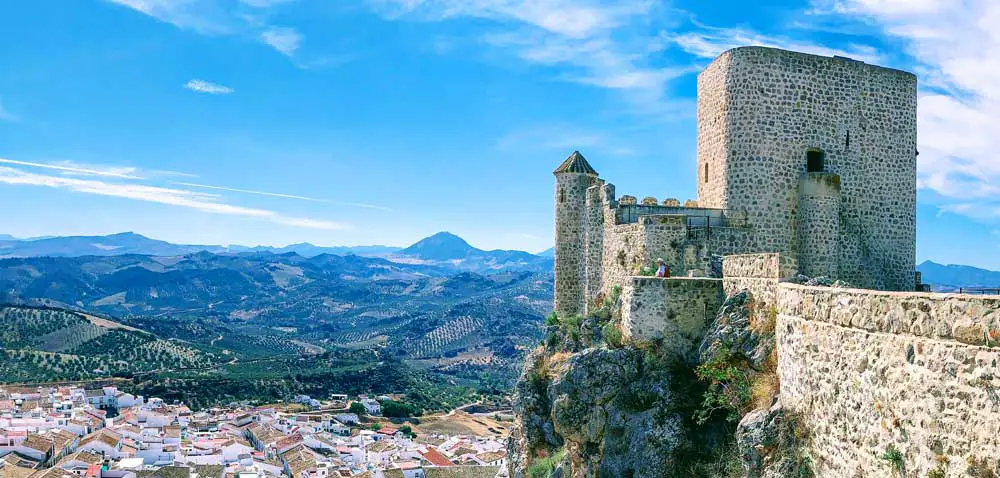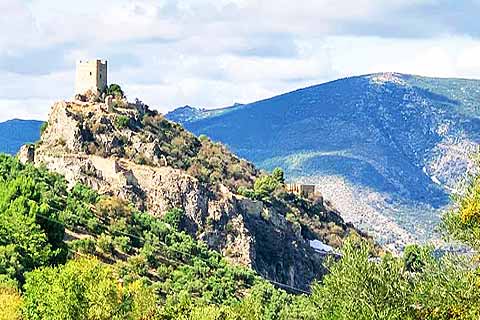Ruta de los Pueblos Blancos
The Famous White Villages of Cádiz
Nestled between three of Andalusia's most famous cities, Malaga, Sevilla, and Cádiz, you will find a string of ancient white villages known as the "Pueblos Blancos".
These pretty villages share a similar past but each is vastly different from the other. While most are built high on the cliffs with imposing towers and castles protecting them from bandits and other dangers, one was built deep into a ravine.
Whatever their differences, they are all steeped in history and culture and today still retain their authentic Moorish roots and charm.
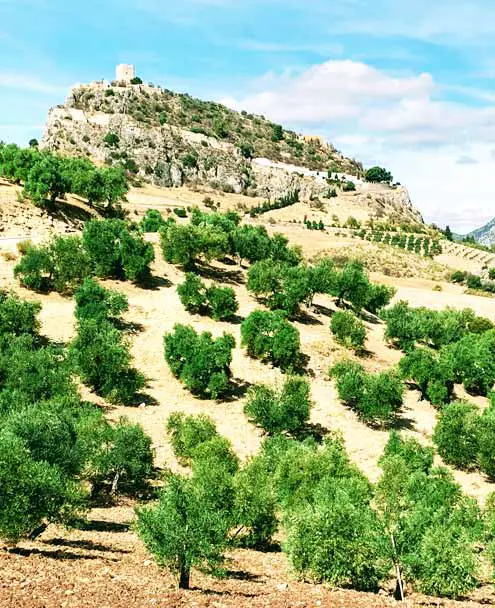
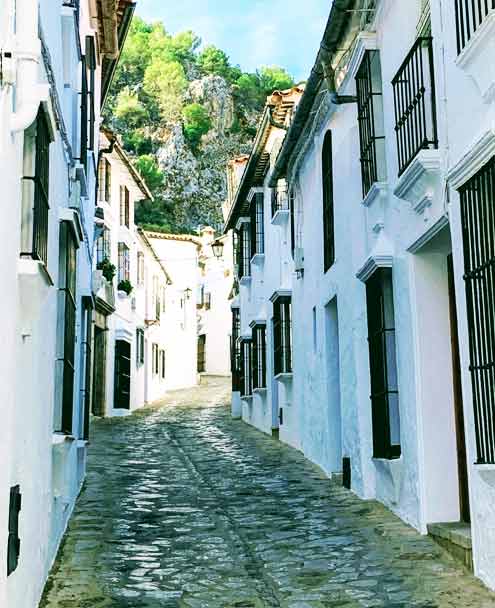
** Zahara & Grazalema - Ruta de los Pueblos Blancos, Cádiz
The "Ruta de los Pueblos Blancos" refers to the "route", or actually "routes" because there are many, that you can follow through the Sierra de Grazalema National Park to visit the most important of these interesting towns. Continue reading to find out which "routes" we recommend and why...
Read about these other incredible areas in Andalucía too!: The Costa Tropical - The Alpujarras - Nerja
Follow the Famous Route of the Pueblos Blancos!
Contents on This Page
- Where are the Famous Pueblos Blancos?
- The History of These Pretty Villages
- How Many Pueblos Blancos are there?
- Top 6 Pueblos Blancos You Must Visit
- Pueblos Blancos on the Map
- TOP Pueblos Blancos Routes
- Best Places to Stay ➜ Pueblos Blancos Route
- Distances Between Towns
- Best Recommended "Pueblos Blancos" Tours
- "Prettiest Villages in Spain" ➜ Winners
- Best Time to Visit the Pueblos Blancos
- Transportation to the Pueblos Blancos
Where are the Famous Pueblos Blancos?
The Pueblos Blancos are mostly located in the northeastern part of the province of Cádiz, in Andalucía. However, the largest of these villages, Ronda, is in the province of Malaga. It is just 1 hour and 30 minutes west of the provincial capital, also called Malaga.These special villages are just 1 hour and 45 minutes east of Cádiz and 1 hour and 45 minutes southeast of Sevilla, so if you are visiting any of these major cities, the Ruta de los Pueblos Blancos is an easy one- or two-day excursion... and well worth your time.

** Sierra de la Grazalema - Ruta de los Pueblos Blancos, Cádiz
The pueblos blancos are known for their stunning natural beauty. The villages themselves are exquisite, but it's their unique surroundings that really make them stand out. Many of the pueblos blancos are located inside the Sierra de la Grazalema Natural Park, an unspoiled mountainous area surrounded by a colorful patchwork of rural farms and bright turquoise lakes. Just driving from village to village is an absolute dream.
The History of These Pretty Villages
The Pueblos Blancos date back to prehistoric times. We know this based on artifacts unearthed in the area and black soot found on the cave ceilings in Setenil de las Bodegas, which were probably used as a natural shelter. The Romans, Moors, and Christians later occupied the area.
Clustered together between mountains, lakes, and lush valleys these rural villages formed the final frontier against the Christians in defense of the Kingdom of Granada.
It was in Zahara, which was perfectly positioned between the great strongholds of Seville and Ronda, where the Christians and the Moors battled over final control of the western border. After having been defeated in a vicious battle, King Ferdinand and Queen Isabel were so enraged that they attacked and finally conquered the Moors in the capital of Granada.

** Olvera - Ruta de los Pueblos Blancos, Cádiz
Also of historical interest are the ruins of the 32-hectare ancient city of Acinipo. Acinipo was an urban area that thrived in the first century AD and had a population of more than 5.000 people. It fell in 429 AD but it's believed that its people moved to Arunda (modern day Ronda) because it was strategically better located.
Acinipo can still be visited today (there is a very impressive Roman Amphitheatre), it's just a 15-minute drive from the town of Setenil. Or take this Free Tour of Acinipo.
How Many Pueblos Blancos are there?
There are about twenty-one (21) pueblos blancos of varying sizes. Ronda is the largest, most well-known, and considered to be the capital. It's also the only one that is not in the province of Cádiz.
Five (5) other "pueblos blancos" stand out for their unique and outstanding beauty, they are: Arcos de la Frontera, Grazalema, Olvera, Setenil de las Bodegas, and Zahara de la Sierra.
The remaining fifteen (15) pueblos blancos are: Alcalá del Valle, Algar, Algodonales, Benaocaz, Benamahoma, Bornos, El Bosque, El Gastor, Espera, Prado del Rey, Puerto Serrano, Torre Alhaquime, Ubrique, Villaluenga del Rosario, and Villamartin.
Top TWENTY (20) Pueblos Blancos You MUST Visit
TOP Pueblos Blancos ➜ RONDA
Known as one of Andalucía's most iconic cities and one of the most visually stunning villages in Spain, Ronda should not be missed.
When one envisions the village of Ronda, the first thing that comes to mind is its striking juxtaposition atop a steep gorge, its two sides joined together by the famous "Puente Nuevo" bridge that falls steeply but elegantly into the ravine.

** Ronda - Ruta de los Pueblos Blancos, Cádiz
Ronda’s cobblestone streets are an absolute pleasure to explore, and the old Roman bridges and historic baths will take you back to a time when Ronda was a power to be reckoned with.
Make sure not to miss these top sites while in Ronda; the Plaza de Toros, the Casa del Rey Moro, El Puente Árabe (Moorish bridge), Palacio del Marqués de Salvatierra, and the Baños de los Árabes (Arab baths).
➜ Being a destination in such high demand you will find a huge assortment of tours to Ronda leaving from the Costa del Sol, Malaga, Granada, and Seville. There are also several free walking tours available within the city itself.
TOP Pueblos Blancos ➜ GRAZALEMA
Resting peacefully under the magnificent "Peñon Grande" is the lovely white village of Grazalema. It lies in the heart of the Sierra de Grazalema National Park, a completely untouched natural reserve replete with soaring mountains, crystalline lakes, and a vast expanse of rolling farmland.

** Grazalema - Ruta de los Pueblos Blancos, Cádiz
Grazalema's quaint "Plaza de España", which is adorned from end to end with bright red geraniums flowing from their pots and presided over by the imposing beauty of its 18th century Iglesia de la Aurora, has been designated as a "Site of Historical Importance" and the village itself has been chosen as one of "Spain's Prettiest Villages".
If you find yourself in this "Pueblo Blanco", join this private tour to learn more about its Moorish history and don't forget to take home some locally made products, such as its wool blankets and artisan cheeses.
TOP Pueblos Blancos ➜ ARCOS DE LA FRONTERA
Surrounded by a colorful patchwork of rolling hills and farms, Arcos de la Frontera is a must do stop on the Ruta de los Pueblos Blancos.
Arcos is yet another of Cádiz's famous "pueblos blancos" that competes with Ronda in its dramatic and breathtaking location atop a staggering rocky cliff along the Guadalete River. A visit to Arcos will reward you with amazing views of its rustic whitewashed homes clinging to the limestone gorge and the church of Santa María de la Asunción reigning over the town from high above.
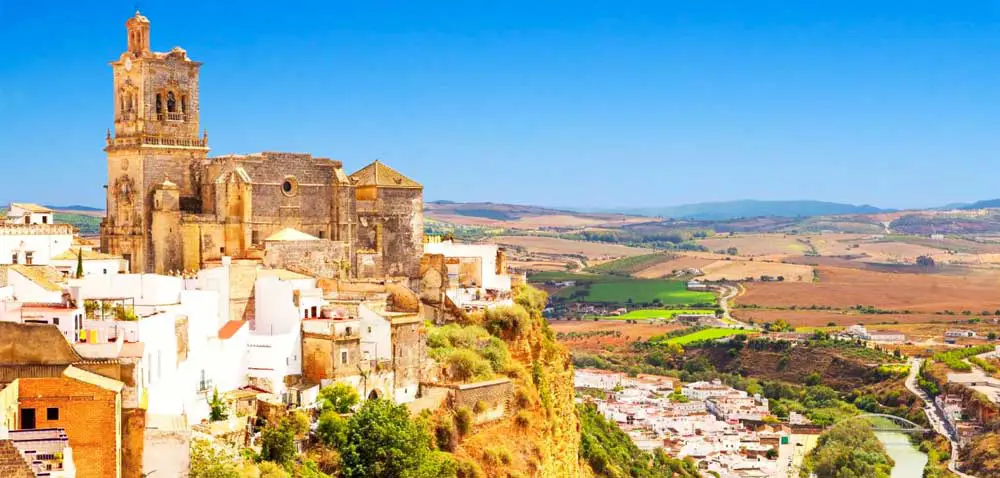
** Arcos de la Frontera - Ruta de los Pueblos Blancos, Cádiz
A walk through its cobblestone streets will reveal its impressive history that dates to the Neolithic and Bronze Ages. Arcos has been inhabited by the Phoenicians, Romans, and later the Moors, all of which contributed to its outstanding architecture and way of life. This is why in 1962 Arcos de la Frontera was recognized as a National Historic and Artistic Monument.
Don't miss seeing the Castillo de los Arcos, the church of Santa María de la Asunción, or the views from the Plaza del Cabildo. If you are staying in Arcos, we recommend the Parador directly across from the castle with panoramic views of the surrounding landscape, and this walking tour of the village.
TOP Pueblos Blancos ➜ ZAHARA DE LA SIERRA
Zahara de la Sierra looks like something out of a fairy tale. On approach the town suddenly appears high on a hill with its houses draping over the edge of a rocky crag. Its formidable castle stands tall at the apex of this story book village and a bright turquoise lake protects it from below.

** Zahara de la Sierra - Ruta de los Pueblos Blancos, Cádiz
Zahara is steep, but worth the climb. It has a very pleasant old town with a central plaza flanked on either end by the Iglesia de Santa Maria de la Mesa and the San Juan de Letran Chapel, both deserving a visit. It's pretty plaza is also lined with good, authentically Spanish restaurants and is a good place to stop for lunch.
After lunch a walk up to the Zahara Castle (Torre del Homenaje) is recommended and you will be rewarded with the best views in all of Andalucía.
To learn more about this history of this beautiful Andalucían village join this private guided walking tour.
TOP Pueblos Blancos ➜ OLVERA
Surrounded on all sides by a sea of olive groves, Olvera is the starting point for the Via Verde, a 38 km award winning hiking / bicycling route along an old, abandoned rail line... once connecting Olvera with a neighboring pueblo blanco, Puerto Serrano.
Thousands of people flock to Olvera every year to cycle through tunnels and over bridges on this now famous route. Restaurants are open along the way, in old railway stations, where cyclist can enjoy a quick snack. A hotel has even been built out of some of the old train cars.

** Olvera - Ruta de los Pueblos Blancos, Cádiz
People have been living in the area around Olvera for more than two thousand years and the village was very active in defending the Kingdom of Granada during Moorish times.
Explore the winding streets of this picturesque white village starting in the Villa neighborhood, the first Moorish settlement, which included the Cathedral (a mosque at that time), the Plaza Iglesia, and the Arab castle.
TOP Pueblos Blancos ➜ SETENIL DE LAS BODEGAS
Of all the pueblos blancos, Setenil de las Bodegas is the most interesting and unique. While most of the nearby villages were built high on a cliffs edge to watch for approaching danger, Setenil had a different strategy...
As you get close to the town of Setenil you will notice that you are driving deep into a mysterious ravine. The people of Setenil decided long ago that the best way to protect themselves was to hide their village within the walls of a steep gorge. You will see as you wander around this pretty village that all the homes and storefronts are built into the cave walls with only the facades facing outward.
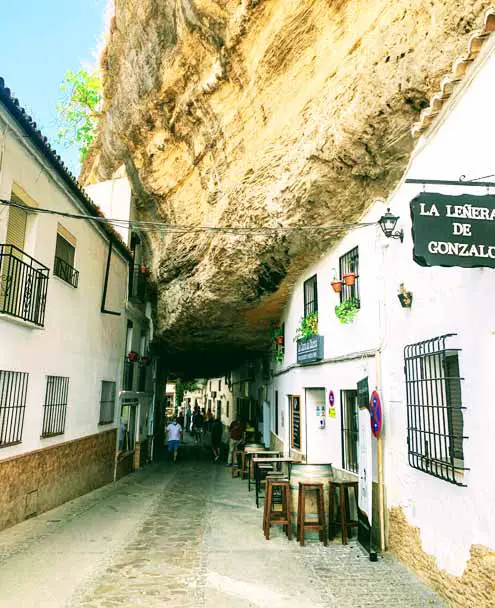
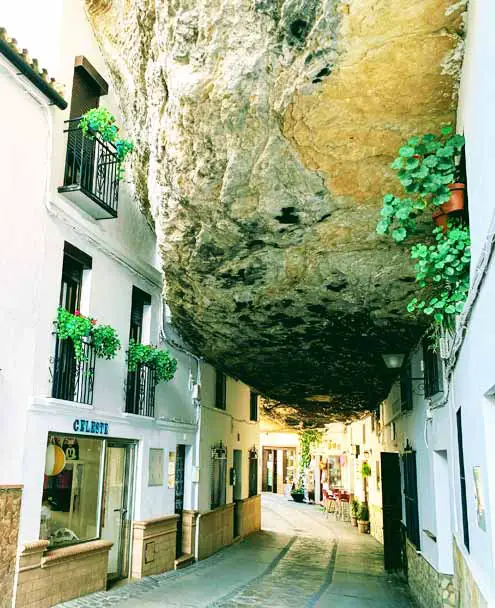
** Setenil - Ruta de los Pueblos Blancos, Cádiz
Two of the most interesting areas of Setenil to visit are the Cueva del Sol and the Cueva de la Sombra. This translates to the "Sunny Cave" and the "Shady Cave". Named appropriately, the Sunny Cave is a long promenade that runs along the sunny side of the River Trejo, protected above by a giant boulder. The Cueva de la Sombra can be found on the shadier side of the river. Both "caves" are bustling with activity and lined with cafes, bars, restaurants, and small shops.
While in Setenil don't miss seeing the Iglesia de Nuestra Señora de la Encarnación, the Nazari Castle (Homage Tower), or the Roman Amphitheatre in the ancient city of Acinipo just outside of town. Walking tours of Setenil are also available, as well as touring one of the cave homes.
SURROUNDED BY ORANGE GROVES AND ARCHAEOLOGICAL SITES
Bornos

** Bornos - Ruta de los Pueblos Blancos, Cádiz
Known as one of the prettiest "pueblos blancos" in Cadiz, because of the beauty of its whitewashed houses and stunning views of the Guadalete River, the charming village of Bornos can be found right in the heart of Andalucia. it has the same typical narrow streets and pretty plazas as the other pueblos blancos but Bornos also boasts medieval walls and an ancient Moorish castle (15th century).
Being only 45-minutes from the coastal capital of Cadiz, Bornos is a great option for a day trip into the Andalucian countryside. Or you could stay in another stunning pueblo blanco, Arcos de la Frontera, and visit Bornos, Espera, and Villamartin in a weekend.
Top sights in Bornos include:
- Castillo Palacio de los Ribera: a ancinet fortress later converted into a palace
- Church of Santo Domingo: a beautiful church with a striking bell tower and ornate Baroque architecture
- Plaza Alcalde José González: a picturesque square in the center of Bornos with fountains and cafes
- The Guadalete River: a scenic river that runs through the village
Alcalá del Valle

** Alcalá del Valle - Ruta de los Pueblos Blancos, Cádiz
Alcalá del Valle is a hidden gem in the heart of the Pueblos Blancos of Cadiz, nestled in a valley between the cities of Malaga and Cadiz. The village has a rich history that dates back to its Arab origins, evident in its picturesque streets and traditional architecture. One of the most charming aspects of Alcalá del Valle is the abundance of balconies overflowing with vibrant flowers, adding a pop of color to the whitewashed walls.
The true jewel of Alcalá del Valle, however, is the ancient dolmens of Tomillo, a must-see for history enthusiasts. The village is surrounded by picturesque mountains and breathtaking natural beauty, perfect for hiking and outdoor activities. Its welcoming locals add to the warm atmosphere, making it an unforgettable experience for all who visit.
Top sights to see in Alcalá del Valle:
- Dolmens of Tomillo: prehistoric monuments dating back to the Neolithic period, located on the outskirts of the village
- Arab Castle: ruins of an Arab fortress located on a hilltop, providing stunning views of the surrounding area
- Plaza de la Constitución: the main square in the village, surrounded by historic buildings and a lovely fountain
- Museum of Popular Arts and Customs: a museum showcasing the traditional way of life in Alcalá del Valle and the surrounding areas
- Natural Pools: a series of pools fed by natural springs, perfect for a refreshing dip on a hot day
Algar

** Algar - Ruta de los Pueblos Blancos, Cádiz
Algar is a hidden gem in the pueblos blancos of Cadiz, located in the heart of the stunning natural park of the Sierra de Grazalema. This beautiful village has been populated since Neolithic times, and its rich history is evident in its charming streets and historic buildings.
One of the highlights of Algar is the impressive house of Pedro Lobato Rodriguez, a true marvel of engineering and craftsmanship. This incredible structure was built entirely by hand, stone by stone, over a period of 20 years. Visitors will wonder whether it's a castle, an Arab palace, or a cathedral under construction.
Another must-see attraction in Algar is the breathtaking scenery of the surrounding mountains, which offer a wealth of outdoor activities for visitors to enjoy.
Top sights in Algar:
- The house of Pedro Lobato Rodriguez: a stunning feat of architecture and construction
- The natural park of the Sierra de Grazalema: a beautiful area with numerous hiking trails and stunning vistas
- The historic center of Algar: with its charming streets and historic buildings, including the beautiful church of San Jorge
Algodonales

** Algodonales - Ruta de los Pueblos Blancos, Cádiz
Algodonales, a picturesque village nestled in the foothills of the Sierra de Líjar, is a hidden gem worth exploring. The village's streets are lined with orange trees, giving it a sweet aroma and vibrant color throughout the year. Algodonales is also known for its twelve beautiful fountains, the sound of trickling water can be heard all over the village.
Aside from its natural beauty, Algodonales is home to several prehistoric sites such as Cueva Santa, Chamusquina, Castillejo, and Cerro de la Botinera. The parish church of Santa Ana, a late baroque-style complex with neoclassical elements, and the hermitages of Jesús Nazareno, Virgencita, and La Concepción (XVIII century) are other must-see monuments.
Highlights of Algodonales:
- The beautiful fountains that adorn the village
- The prehistoric sites, revealing the area's ancient history
Top sights to see:
- Visit the parish church of Santa Ana and admire its beautiful architecture
- Explore the prehistoric sites of Cueva Santa, Chamusquina, Castillejo, and Cerro de la Botinera
- Take a walk along the streets of the village, filled with the scent of oranges
- Visit the hermitages of Jesús Nazareno, Virgencita, and La Concepción to learn about the area's religious history
Benaocaz

** Benaocaz - Ruta de los Pueblos Blancos, Cádiz
Declared a "Site of Cultural Interest" in 1985, Benaocaz boasts a labyrinth of narrow cobblestone streets, a charming Nasrid quarter, and picturesque whitewashed houses adorned with vibrant flowerbeds. The village is also home to several 18th-century manor houses and impressive prehistoric remains, such as the Sima de la Veredilla and the Cuevas de la Manga. Visitors can explore the XIII-XIV century castle of Aznalmara and a remarkable Roman road that once connected the village with Ubrique, its most noteworthy archaeological remain.
Top Sights to See
- Labyrinth of narrow cobblestone streets - the parish church of San Pedro Apóstol, the hermitages of Calvario and San Blas, the Abrevadero, the public fountain and the town hall.
- Whitewashed houses with colorful flowerbeds
- 18th-century manor houses
- Prehistoric remains such as the Sima de la Veredilla and the Cuevas de la Manga
- Remarkable Roman road that once connected the village with Ubrique
Benamahoma: A Mountain Haven

** Benamahoma - Ruta de los Pueblos Blancos, Cádiz
Nestled in the heart of the Sierra de Grazalema, Benamahoma is a mountain village like no other. With its tranquil streets and breathtaking views, this village is a haven for nature lovers and anyone seeking a peaceful getaway.
Benamahoma's name is said to mean "son of Mohammed," a nod to its Moorish past. Today, it's a charming and welcoming community that's perfect for walkers and hikers looking to explore the Sierra.
Highlights of Benamahoma
- Stunning views of the Sierra de Grazalema
- Tranquil streets perfect for a leisurely stroll
Top Sights to See in Benamahoma
- Plaza del Ayuntamiento with its horseshoe-shaped arcading and long pools
- Plaza de España, a large square overlooking the valley, has a horseshoe-shaped entrance arch, as well as a fountain with Moorish detailing
- castilito ofhermita-mezquita, An interesting mix of Christian and Islamic.
- The Parque Natural de la Sierra de Grazalema, a protected natural park that's home to a diverse array of flora and fauna
El Bosque: A Gem in the Sierra de Albarracín

** El Bosque - Ruta de los Pueblos Blancos, Cádiz
Located in the heart of the Sierra de Albarracín and nestled near the Majaceite River, El Bosque is a picturesque mountain village with a rich history. Once home to the Duke of Arcos, the village boasts white streets dotted with fountains and flowers, providing a tranquil escape from the bustling nearby cities.
Two highlights of the village include the stunning Nuestra Señora de Guadalupe church and the historic ducal palace. Other notable sights to see include:
- The hermitage of Calvario, a charming 17th-century chapel
- The bullring, a beloved local landmark with a rich history
- The botanical garden "El Castillejo," which showcases the diverse flora of the region
- The ruins of the castle of Tavizna, a fascinating archaeological site with sweeping views of the surrounding landscape
- The village's many medicinal springs, which offer a refreshing and rejuvenating experience for visitors
With its lush forests and abundance of outdoor activities, including hiking, fishing, and rock climbing, El Bosque is a must-visit destination for nature lovers and adventure seekers.
El Gastor

** El Gastor - Ruta de los Pueblos Blancos, Cádiz
El Gastor is a picturesque village located near the Guadalete river, surrounded by typical mountain villages. It has been populated since prehistoric times, leaving behind impressive megalithic monuments such as the Dolmen del Gigante.
The village is also known as the Balcony of the White Villages for its magnificent panoramic views of the Gastor lake and neighboring villages. Visitors can explore the charming white streets and visit the church of San José, the Diego de El Gastor fountain, the Palomino Brothers oil mill, and the museum of Usos y Costumbres.
- Dolmen del Gigante: an ancient megalithic tomb located next to El Gastor.
- The church of San José, a 16th-century structure with a stunning bell tower and beautiful frescoes.
- The Diego de El Gastor fountain, a charming landmark built in the 19th century that offers refreshing spring water.
- The Palomino Brothers oil mill, which produces high-quality olive oil and offers tours for visitors.
- The museum of Usos y Costumbres, which showcases traditional tools and crafts of the region, providing a glimpse into local customs and traditions.
Espera: A Hidden Gem in Cadiz

** Espera - Ruta de los Pueblos Blancos, Cádiz
Located just a short distance from the ancient Roman city of Carissa Aurelia, Espera is a picturesque village steeped in history and surrounded by natural beauty. The village's rich history is evident in the remains of the Iberian-Roman Funerary World of Espera, which can be explored at the local archaeological museum.
Some of the top sights to see in Espera include:
- The necropolis and walled urban enclosure of Carissa Aurelia
- The Paleochristian tombstone with inscriptions
- The Esperilla archaeological site with remains dating back over 3,000 years
- The picturesque village streets dotted with traditional Andalusian architecture
- The stunning natural surroundings, including the Guadalete River and nearby Sierra de Grazalema Natural Park
Espera is an ideal destination for history buffs and nature lovers alike, and its proximity to the Roman ruins of Carissa Aurelia make it an essential stop on any tour of Cadiz.
Prado del Rey in Cadiz

** Prado del Rey - Ruta de los Pueblos Blancos, Cádiz
Prado del Rey, a charming pueblo blanco of Cadiz, is a perfect day trip from Cadiz, located just 95 km away. a sight to behold. Surrounded by rugged mountains and fields of green, Its rich history and heritage can be felt in every stone, From the Roman city of Iptuci to the Phoenician salt mines
Rooted in the Roman city of Iptuci, Prado del Rey's rich history spans from the Neolithic to the 15th century, as confirmed by the archaeological site of Iptuci.
Top Sights to See in Prado del Rey:
- Explore the Roman ruins of Iptuci, an important archaeological site declared an Asset of Cultural Interest.
- Visit the salt mines near Cabeza de Hortales, which were already being exploited by the Phoenicians.
- Admire the stunning parish church of Nuestra Señora del Carmen.
- Discover the old Pósito de Labradores, a traditional building that used to store crops.
- Taste the local cuisine, including the alboronía of chickpeas and peppers, torrijas with honey, and the famous must of Pajarete.
- Visit the Honey Fair, where you can sample and purchase some of the best honey in the region.
Puerto Serrano

** Puerto Serrano - Ruta de los Pueblos Blancos, Cádiz
Puerto Serrano is a charming white village nestled among the rolling hills of Andalusia in the province of Cadiz. This pueblo blanco of Cadiz is surrounded by orange groves and has a rich history dating back to the Paleolithic era. It boasts numerous archaeological sites, including the ancient Roman settlement of Cerro Castelar, Fuente de Ramos, and El Almendral, which showcase the area's fascinating past.
For outdoor enthusiasts, the Vía Verde de la Sierra is an idyllic destination for hiking, cycling, and horseback riding. This green trail runs along the old Jerez-Almargen railway line, stretching for 35 km between Puerto Serrano and Olvera. Along the way, visitors can enjoy breathtaking views of the Sierra de Cadiz and discover the surrounding countryside.
Other must-visit sights in Puerto Serrano include:
- Pozo Amargo: This village features the ruins of its castle, providing a glimpse into the area's rich history.
- SENDERO FUENTE DE RAMOS: This trail, surrounded by olive groves, starts in Puerto Serrano and passes the sites of Fuente de Ramos and the hermitage of Almendral.
- Vía Verde de la Sierra: A cycling track that runs along an old railway line. It's 36.5 km long and links Puerto Serrano and Olvera.
Torre Alháquime

** Torre Alháquime - Ruta de los Pueblos Blancos, Cádiz
Torre Alháquime is a charming pueblo blanco located in the province of Cadiz, surrounded by stunning natural landscapes and rich cultural heritage. Its whitewashed houses are perched on a hill, offering panoramic views of the Sierra de Lijar and the Guadalete river valley. The village is just a short drive away from the historic city of Ronda, making it an ideal day trip destination.
Nature lovers will also find plenty to explore in Torre Alháquime, such as the nearby Lijar Natural Park, where hiking trails lead to spectacular viewpoints and ancient cave paintings. The village is also known for its traditional crafts, such as ceramics and basket weaving, which can be purchased at local shops and markets.
Must-visit sights in Torre Alháquime:
- 14th-century Moorish tower, which gives the village its name. Visitors can climb to the top of the tower for breathtaking views of the surrounding countryside
- church of San Juan Bautista,
- the Castle of Fatetar
- archaeological site of Medina Sidonia
Ubrique

** Ubrique - Ruta de los Pueblos Blancos, Cádiz
Ubrique, a picturesque village nestled in the mountains where the natural parks of Grazalema and Los Alcornocales meet, is a true gem of Cadiz's pueblos blancos. Declared a Historic Site, Ubrique boasts a rich history and culture dating back to the Roman period, with the remains of an ancient Roman road between Ubrique and Benaocaz. From the Muslim culture, the castle of Fatima (XII century) still stands as a testament to the town's past.
The winding streets of the medieval old town are lined with white houses adorned with colorful flower pots, picturesque squares with fountains, and churches with impressive baroque facades, such as the churches of San Antonio, San Juan de Letrán, and the Convent of Capuchinos. Outdoor enthusiasts will find plenty of hiking trails to explore the stunning natural surroundings.
Must-visit sights in Ubrique:
- The medieval historic center with its narrow streets and beautiful squares
- The remains of the XII century castle of Fatima
- The churches of San Antonio, San Juan de Letrán, and the Convent of Capuchinos
- The natural parks of Grazalema and Los Alcornocales
- The ancient Roman road between Ubrique and Benaocaz
- The abundance of hiking trails in the Sierra de Cádiz
Villaluenga del Rosario

** Villaluenga del Rosario - Ruta de los Pueblos Blancos, Cádiz
Nestled in the heart of the Sierra de Grazalema Natural Park, Villaluenga del Rosario stands proudly as one of the most picturesque and unique Pueblos Blancos in Cadiz. This charming village, located just a short drive from Cadiz, offers breathtaking views of the rugged mountains and stunning countryside. It's a place where time seems to have stood still, and traditional Andalusian culture thrives.
Villaluenga del Rosario is home to some of the best artisanal cheese in the region, which is made using age-old methods that have been passed down through generations. It is home to the oldest cheese factory in the province of Cadiz, where the famous Payoyo cheese is produced. This cheese is made from the milk of the Payoya goat, a breed native to the Sierra de Grazalema area. The factory offers tours and tastings for visitors to learn about the cheese-making process and sample the different varieties.
Its historic streets and buildings are adorned with colorful flowers, and its people are friendly and welcoming. Visitors can explore the village's rich history and culture through its ancient ruins, traditional festivals, and historic landmarks, including the remains of an ancient Moorish castle. Whether you're a foodie, a history buff, or a nature lover, Villaluenga del Rosario is a must-see destination for anyone visiting Cadiz.
Must-visit sights in Villaluenga del Rosario:
- Quesos Payoyo: This award-winning cheese factory is located right in the heart of the village and offers guided tours where you can learn about the cheese-making process and sample some of their delicious products.
- Iglesia de San Miguel Arcángel: This beautiful church, located in the center of the village, dates back to the 16th century and is an excellent example of Andalusian Baroque architecture. Its stunning facade, ornate altar, and impressive bell tower make it a must-visit for history and architecture buffs alike.
Villamartin

** Villamartin - Ruta de los Pueblos Blancos, Cádiz
Villamartin is a picturesque pueblo blanco located in the province of Cadiz. It is nestled in the Sierra de Cádiz Natural Park and is surrounded by stunning landscapes of olive groves and cork oak forests. Villamartin is situated just over an hour's drive from the city of Cadiz and is the perfect destination for a day trip from the coast. The town is known for its rich history, evident in its architecture and cultural heritage. The town's name comes from its history of being a settlement under the control of the Order of Santiago. It boasts a beautiful church, San Andres, that dates back to the 16th century, as well as other notable historical buildings such as the Palacio del Marqués de Aguayo.
Must-visit sights in Villamartin:
- San Andres Church: A stunning 16th-century church located in the heart of the town.
- Palacio del Marqués de Aguayo: A beautiful historical building with an impressive façade.
- Sierra de Cádiz Natural Park: A vast natural park that surrounds Villamartin, offering incredible hiking trails and breathtaking views.
Pueblos Blancos on the Map
As you can see on the map below, all twenty-one (21) pueblos blancos are sprinkled throughout the northern part of Cádiz, and all are relatively close together. You could easily see two or three in a day.
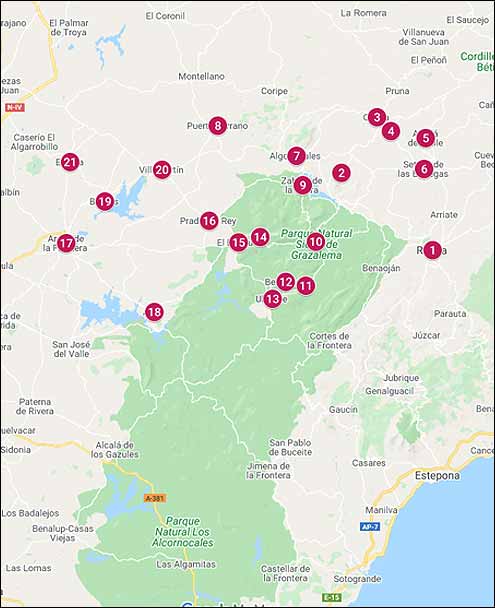
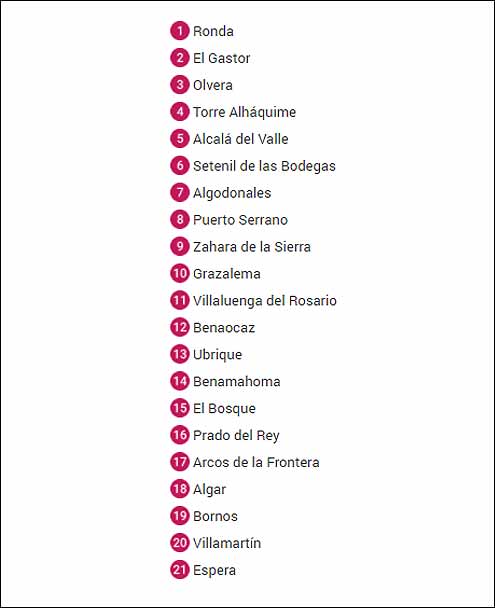
** 21 Villages - Ruta de los Pueblos Blancos, Cádiz
Ruta de los Pueblos Blancos - THREE (3) Itineraries
If you are thinking about following the "Ruta de los Pueblos Blancos" and visiting some of these stunning villages, we suggest you stay in one of three places; Ronda, Grazalema, or the area around El Gastor.
Staying in any of these three towns will allow you to see many of the pueblos blancos in two short days by following one of the itineraries below...

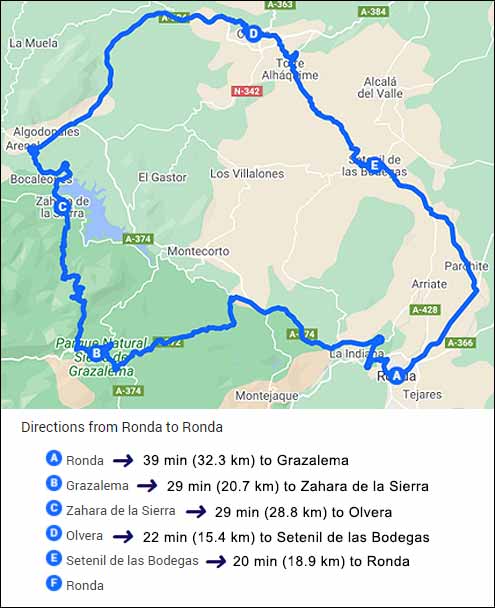
** The Ronda Route - Ruta de los Pueblos Blancos, Cádiz
The Ronda Route
The first route we recommend, which takes you to four of the TOP "pueblos blancos", is the Ronda route. This route assumes you are staying in the town of Ronda. If you haven't already planned a night in Ronda, you definitely should!This route is done in one or two days, depending on how much time you have, but if you visit all four villages in one day it will take about 10 hours and you will have to stay on a tight schedule. We recommend doing it in two days, to make the most out of your trip.
Ronda Route - One Day
Start this itinerary early in the morning, around 8:00 am and for Ronda hotel recommendations read the "BEST Places to Stay ➜ Ronda Route" section below.
| Time | From | To | Arrive | Visit |
| 8:00 | Ronda | Grazalema | 8:40 | 2h |
| 10:40 | Grazalema | Zahara | 11:10 | 3h |
| 14:10 | Zahara | Olvera * | 14:40 | 2h |
| 16:40 | Olvera | Setenil | 17:05 | 2h |
| 19:00 | Setenil | Ronda | 19:20 | - |
* If you are running out of time, drop Olvera and go directly from Zahara to Setenil (43 minutes / 32 km).
Ronda Route - Two Days
This route is more relaxed and will give you at least three hours to visit each village.Day One:
| Time | From | To | Arrive | Visit |
| 9:00 | Ronda | Grazalema | 9:40 | 3h |
| 12:40 | Grazalema | Zahara | 13:10 | 3h |
| 16:10 | Setenil | Ronda | 16:50 | - |
Day Two:
| Time | From | To | Arrive | Visit |
| 9:00 | Ronda | Olvera | 9:45 | 3h |
| 12:45 | Olvera | Setenil | 13:10 | 3h |
| 16:10 | Setenil | Ronda | 16:30 | - |
BEST Places to Stay ➜ Ronda Route
Ronda is an amazing town with a lot to see. We suggest spending at least a day and a half in Ronda, then venturing out to see the other "Pueblos Blancos".



El Gastor Route - Two Days
Another option for a wonderful rural holiday is to stay in Ronda for a night or two and then move on to the El Gastor area. From El Gastor you can visit many of the most popular pueblos blancos as well as some of the smaller off the beaten track ones.
This route will be done in two days.


** El Gastor Route Day 1 & 2 - Ruta de los Pueblos Blancos, Cádiz
BEST Places to Stay ➜ El Gastor Routes
The advantage of staying in El Gastor versus Ronda is the stunning natural beauty of the El Gastor Lakes and surrounding areas. You will be staying in a rural home with a swimming pool and stunning views versus a hotel or hostel in town.El Gastor is a tiny village and doesn't have many hotels or hostels, but it has been rated as one of the BEST areas to rent rural villas in all of Spain. Here are three of our recommendations below:



The Grazalema Route - Two Days
Grazalema is one of the prettiest of the pueblos blancos and is right in the heart of the incredible Sierra de Grazalema National Park, making it a wonderful place to spend two or three days. The hiking in the Grazalema area is also fantastic and worth doing.

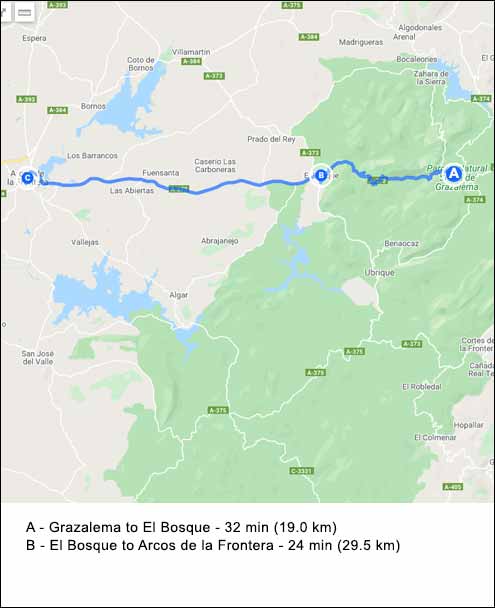
** Grazalema Route Day 1 & 2 - Ruta de los Pueblos Blancos, Cádiz
On the Grazalema Route, you will see five of the top pueblos blancos and some of the popular smaller ones. It's a little further away from a few of them (Olvera & Setenil), compared to El Gastor, so you will have to do a little more driving.
The advantage of staying in Grazalema is that you are also closer to Arcos de la Frontera, one of the must-see pueblos blancos that didn't make it on the other itineraries.
If you have extra time, you will find these villages less than half an hour from Grazalema: Benaocaz (26 min (19.5 km)), Benamahoma (22 min (13.3 km)), Prado del Rey (36 min (27.1 km)), Ubrique (36 min (26.3 km)), Villaluenga del Rosario (20 min (13.5 km)), and Villamartin (44 min (37.9 km)).
BEST Places to Stay ➜ The Grazalema Route

We also recommend in Grazalema...
- Villa Turística de Grazalema - Our second favorite! A rural hotel with self-catering cottages.
- Puerta de la Villa - A four-star hotel, BEST location in town!
- Peñon Grande - A two-star budget friendly option off the main plaza.
- Camping Tajo Rodillo - Grazalema's campsite, great for hikers!
Distances Between the Pueblos Blancos & Other Cities
Larger Cities ➜ RondaMalaga: 1 hr 26 min (102.5 km)
Marbella: 1 hr 8 min (63.1 km)
Cádiz: 1 hr 46 min (145.5 km)
Sevilla: 1 hr 46 min (133.0 km)
Cordoba: 2 hr 15 min (167.0 km)
Smaller White Villages ➜ Ronda
Jerez de la Frontera: 1 hr 32 min (115.4 km)
Arcos de la Frontera: 1 hr 10 min (85.0 km)
Zahara de la Sierra: 39 min (36.4 km)
Olvera: 44 min (34.3 km)
Setenil de las Bodegas: 21 min (18.9 km)
Grazalema: 39 min (33.5 km)
Oficina de Información Turística
Ruta de los Pueblos Blancos
Plaza Blas Infante, s/n, 29400
Ronda, Málaga
Telephone: +34 952 18 71 19
Hours:
10:00 am - 14:00 pm
Email address: informacion@turismoderonda.es
BEST Recommended Tours to the "Pueblos Blancos"
The natural environment throughout the Sierra de Grazalema and the Sierra de Cádiz is so spectacular that if you have a car... we recommend you drive.If you don't have a car and want to visit these charming pueblos blancos, rent one, or join a tour that leaves from Ronda, Malaga, Sevilla, or Granada. Most stop in at least two or three of the villages.


Try these other unique tours and experiences of the Pueblos Blancos and Ronda!
- Organic Estate & Olive Oil Tasting Experience,
- Private Tour of Grazalema,
- Private Tour of Zahara de la Sierra,
- Free Walking Tour of Ronda,
- Setenil de las Bodegas Tour
Other Important Information You Should Know About the Pueblos Blancos
1. "Prettiest Villages in Spain" ➜ Winners
Not only are the Pueblos Blancos beautiful but three of them have been chosen as "winners" by the Association of The Most Beautiful Villages in Spain.
The "Association of The Most Beautiful Villages in Spain" was formed in 2013 to recognize the country's most picture-perfect villages, inspired by the Les Plus Beaux Villages de France ('most beautiful villages in France') association. It began with a group of sixteen villages and over the years it has gradually added locations to reach a total of 94 villages throughout Spain.
Out of the five villages that have been chosen in the Province of Cádiz, three have been part of the "Ruta de los Pueblos Blancos"; Grazalema, Zahara de la Sierra, and Setenil de las Bodegas. The other two are: Vejer de la Frontera and Castellar de la Frontera.
2. When is the Best Time to Visit the Pueblos Blancos?
- During the months of April, May and October you are most likely to experience good weather with pleasant average temperatures that fall between 20 degrees Celsius (68°F) and 25 degrees Celsius (77°F).
- On average, the warmest month(s) are July and August, with July being the hottest.
- The months of January, February, March, April, August, September, and October have a high chance of precipitation, with November being the wettest (average in Grazalema is over 800 mm - the highest in Spain).
- On average, the coolest month is January.
- June is the driest month.
3. Transportation to Ronda & Pueblo Blancos
From Malaga: 1 hr 23 min (102 km) follow the A-357 and A-367 to Ronda.
From Cádiz: 1 hr 43 min (145 km) take the A-384 to Ronda.
From Seville: 1 hr 43 min (133 km) via A-375 and A-374 to Ronda.
Save money on your next trip with our favorite travel websites!
| Find the Cheapest Hotels: | |
| The Largest Selection of Villas & Apartments: | |
| Cheapest, Most Reliable Car Rentals: | |
| Best Bus & Train Fares: | |
| Huge Selection of the BEST Tours & Activities | |
| Discount Tickets to Museums & Attractions | |
